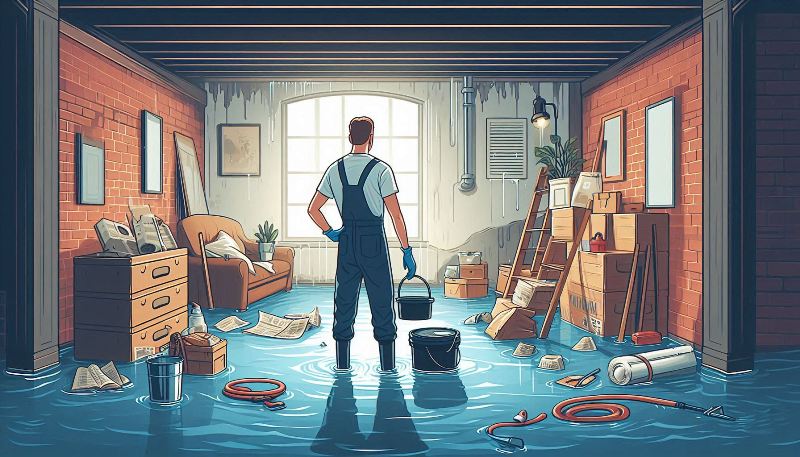Common Causes of Basement Flooding
Basement flooding is a common plight for many homeowners. The most frequent causes range from heavy rainfall, rapid snowmelt, and poor drainage systems to more systemic issues like foundation cracks and malfunctioning sump pumps. For instance, if you live in an area prone to heavy rain, like Denver, you might be particularly at risk. Addressing Basement Water Damage Denver can be a unique challenge due to the local climate conditions.
To prevent basement flooding, it’s crucial to identify underlying causes like inadequate landscaping, clogged gutters, improper sump pump maintenance, and drainage system issues. Early identification can help take preventative measures and protect your home in the long term. Taking care of these problems may shield your family from water damage and provide a secure atmosphere.
Signs Your Basement is Prone to Flooding
Early detection can make a considerable difference when it comes to basement flooding. Some telltale signs include water stains on the walls or floors, a persistent musty odor, and visible cracks in the foundation. Additionally, minor leaks that worsen during rainfall or snowmelt indicate a potential flooding issue. Other symptoms may include peeling paint, rust on metal fixtures, and visible mold or mildew. Proactive inspection and maintenance can save you from extensive repair costs.
Preventative Measures
Flood prevention starts with understanding your home’s vulnerabilities and addressing them proactively. Here are some prevention measures to consider:
- Proper Lawn Grading: To avoid water buildup, ensure the land surrounding your house slopes away from the foundation. Poor grading may cause water to gather on a home’s foundation, significantly raising the possibility of basement flooding.
- Maintain Gutters and Downspouts: Regularly clean gutters to ensure proper water flow and extend downspouts at least 5 feet from the foundation. This prevents water from overflowing and seeping into your basement.
- Install Sump Pumps: A sump pump can significantly reduce flooding risks by directing water away from your basement. Regular maintenance and occasional testing are crucial to ensure its optimal performance when needed.
- Seal Cracks and Gaps: Check for holes in the walls and seal them to prevent water from reaching your foundation. Use waterproof sealants to reinforce your basement walls and floors. Additionally, consider applying a waterproof coating to the exterior of your foundation for extra protection.
For more comprehensive strategies, refer to this FEMA resource, which provides detailed guidelines for flood prevention and home maintenance. By taking these precautionary actions, you may secure your house and lessen the chance of basement flooding.
Step-by-Step Basement Flood Cleanup Guide
If your basement does flood, acting swiftly is crucial to minimize damage. Follow this step-by-step guide to manage the cleanup process effectively:
- Ensure Safety: Before entering the flooded area, disconnect all electrical appliances and turn off any power sources to avoid electric shock. You must use protective clothing, such as boots, masks, and gloves, to shield yourself from any pollutants or harmful elements that could be present in the floodwater.
- Remove Water: Removing standing water is a critical step. Utilize a wet/dry vacuum or a sump pump to eliminate water efficiently. If the volume of water is substantial, you might need to rent industrial-grade equipment. Follow the manufacturer’s instructions and keep electrical devices out of the water.
- Dry the Area: Use dehumidifiers and fans to dry the basement thoroughly. Be careful of any nooks and crannies, as mold can grow if there is leftover moisture. If weather permits, open windows to increase air circulation and speed up drying. Consider using air movers or other specialist drying equipment to reach hard-to-reach locations.
- Sanitize: Clean all surfaces, including walls, floors, and furniture, with a disinfectant to eliminate bacteria and prevent mold. Pay special attention to areas that have absorbed water, such as carpets and upholstered furniture. Discard any items that cannot be adequately sanitized, such as mattresses and certain types of flooring.
- Inspect for Damage: After the area is dry, inspect for structural damage or signs of mold. If you detect severe damage, consider consulting a structural engineer or a mold remediation specialist. Take pictures of the damage and keep track of any repairs that need to be made for insurance purposes.
When to Call in the Professionals
Professional intervention is crucial in severe basement flooding, mold growth, or structural damage that DIY cleanup efforts cannot handle. Expert restoration services have the knowledge and tools to manage intricate situations, support insurance requests, and offer advice on averting such occurrences in the future. It is essential for home safety to be aware of any possible health concerns related to flooding and to take the necessary precautions to reduce such risks. They can also help assess long-term risks, recommend foundation upgrades, and provide regular maintenance tips to keep your basement dry and safe. For more expert guidance on flood safety, refer to the CDC article.

